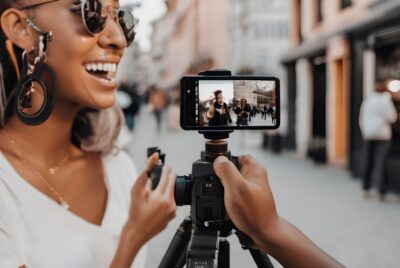Photography Therapy: Exploring the Healing Power
1. Introduction: The Therapeutic Lens
As someone deeply passionate about both photography and the potential for healing through self-expression, I’m thrilled to guide you through the remarkable world of photography therapy. In this article, we’ll explore how the simple act of taking photographs can become a powerful tool for self-discovery, mindfulness, and emotional well-being.
The Convergence of Art and Healing
Photography therapy represents the beautiful convergence of art and healing. Through the lens of a camera or smartphone, we can capture not just images but also our inner worlds, thoughts, and emotions.
Why Photography Therapy Matters
Before we dive into the practical aspects, let’s understand why it is relevant. It offers a unique opportunity for self-expression, healing, and personal growth, making it a valuable practice for individuals from all walks of life.
2. The Healing Potential of Photography
At its core, photography therapy recognizes the inherent healing potential of photography. We’ll explore how the simple act of taking photos can facilitate self-reflection, mindfulness, and even catharsis.
Photography as a Reflective Tool
Photography serves as a reflective tool, allowing us to externalize our thoughts and emotions. When we capture moments, we engage with our surroundings in a profound way, encouraging mindfulness and self-awareness.
Catharsis Through Captured Moments
Photography therapy acknowledges the therapeutic value of capturing moments. By documenting our experiences and emotions, we can process and release pent-up feelings, achieving a sense of catharsis.
2.1. Mindful Photography
Mindfulness is at the heart of photography therapy. We’ll delve into techniques for practicing mindfulness through photography, helping you engage with the present moment and find inner peace.
Photographing with Presence
Mindful photography encourages us to be fully present while capturing images. We’ll explore how this practice can enhance the quality of your photographs and your emotional well-being.
Connecting with the Present Moment
Mindfulness and photography go hand in hand. Discover how photography can help you connect with the present moment, fostering a sense of mindfulness and calm.
3. The Therapeutic Process
Now that we’ve established the healing potential of photography, let’s delve into the therapeutic process itself. We’ll discuss how to find your therapeutic focus and use visual journaling for self-exploration.
Finding Your Therapeutic Focus
Identifying themes and subjects that resonate with your emotional journey is essential. We’ll guide you through this process, helping you discover what speaks to you.
Visual Journaling
Visual journaling involves using photography as a means of documenting and exploring your thoughts, feelings, and experiences. We’ll explore how this practice can lead to profound self-discovery.
3.1. The Power of Self-Portraiture
Self-portraiture is a unique and potent aspect of this form of therapy. We’ll discuss how taking self-portraits can be a powerful form of self-expression and self-discovery.
Self-Expression and Healing
Self-portraits provide an opportunity to express yourself in a safe and creative way. We’ll explore how this practice can be a transformative tool for healing.
Reframing Self-Perception
Self-portraits can challenge and redefine your self-image. We’ll discuss how this process can lead to increased self-acceptance and personal growth.
4. Building a Photography Therapy Practice
To embark on a photography therapy journey, you’ll need the right equipment and a supportive environment. We’ll explore the considerations for choosing the appropriate tools and creating a safe space for your practice.
The Right Equipment
Whether you’re using a camera or smartphone, selecting the right equipment is crucial. We’ll help you make informed choices based on your needs and preferences.
Creating a Safe Space
Designing a nurturing and safe environment for your sessions is essential. We’ll offer tips on setting up your space for maximum comfort and creativity.
4.1. Solo or Guided Practice
Photography therapy can be practiced independently or with the guidance of a therapist or coach. We’ll discuss the advantages of each approach and how to choose what’s right for you.
Exploring Self-Guided Therapy
If you prefer a self-guided approach, we’ll provide tips and techniques to help you make the most of your therapy practice.
Working with a Therapist or Coach
For those seeking professional guidance, we’ll explore the benefits of working with a therapist or coach specializing in photography therapy.
5. The Art of Sharing and Feedback
Sharing your photography therapy journey with trusted individuals can enhance the therapeutic process. We’ll discuss how to share your work and receive constructive feedback.
Sharing Your Journey
Opening up and sharing your photos with others can be a transformative experience. We’ll explore the benefits of sharing and the connections it can foster.
Receiving Constructive Feedback
Constructive feedback is invaluable in your growth as a photographer and as an individual. We’ll discuss how to seek and receive feedback that supports your journey.
5.1. Photography Therapy Communities
Photography therapy communities, both online and offline, provide a sense of belonging and support. We’ll explore the advantages of joining such communities and how to showcase your work to a wider audience.
Online and Offline Communities
Discover the benefits of connecting with like-minded individuals who share your passion.
Showcasing Your Work
We’ll discuss platforms and methods for sharing your photography therapy journey with a wider audience, whether you’re seeking inspiration or feedback.
6. Measuring Progress and Growth
As you continue your photography therapy practice, it’s essential to measure your progress and set personal goals. We’ll provide guidance on evaluating your work and using it as a tool for personal growth.
Evaluating Your Photography
We’ll explore techniques for assessing the evolving themes and emotions in your work, helping you gain insights into your journey.
Setting Personal Goals
Photography therapy offers a unique opportunity to set personal goals for self-improvement. We’ll discuss how to harness this potential for growth.
7. Case Studies: Real-Life Transformations
To illustrate the power of this therapy, delve into inspiring case studies. These real-life stories highlight the profound changes individuals have experienced through this practice.
Personal Stories of Healing
Explore accounts of individuals who have found healing, self-discovery, and personal growth through photography therapy.
A Glimpse into the Therapeutic Process
We’ll take a closer look at specific therapy techniques used in these cases, offering valuable insights into the practice.
8. Conclusion: Embrace the Healing Lens
As we conclude our exploration of photography therapy, I encourage you to embrace the healing lens. This practice has the potential to accompany you on a lifelong journey of self-discovery and emotional well-being.
9. FAQs
Before we part ways, let’s address some common questions about photography therapy.
9.1. Can I practice photography therapy even if I’m not a skilled photographer?
Absolutely! Photography therapy is about self-expression and self-discovery, not technical expertise.
9.2. How does photography therapy compare to traditional talk therapy?
Photography therapy offers a different approach, using images as a medium for expression and healing. It can complement traditional therapy or be a standalone practice.
9.3. Are there specific photography styles that work better for therapy?
No specific style is required. Your chosen style should reflect your emotions and experiences.
9.4. What are some tips for finding emotional themes to explore in my photography therapy practice?
Explore your feelings and experiences, and let them guide your photographic themes.
9.5. How can I maintain consistency in my photography therapy practice?
Set aside dedicated time, create a supportive routine, and stay committed to your journey.
Further Reading
Check out our other relevant articles:
- American Psychological Association – Photography as Therapy – The American Psychological Association explores the psychological benefits of photography as a therapeutic tool, shedding light on the intersection of photography and mental health.
- Psychology Today – The Healing Power of Photography – This Psychology Today article delves into the healing potential of photography, discussing how it can be used as a means of self-expression and emotional healing.
________________________________________
With this comprehensive guide, you’re now equipped to embark on your own photography therapy journey. Whether you’re a seasoned photographer or a complete novice, this practice has the potential to transform your life. Embrace the therapeutic power of photography, and let your healing journey begin.




